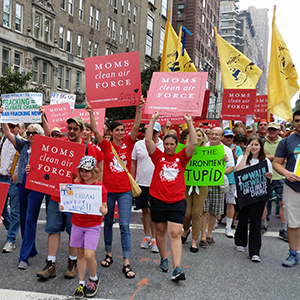This piece was cross-posted from Writes Like She Talks
Each of my Moms Clean Air Force posts includes a reminder that asks you to please consider joining the Moms Clean Air Force and help fight for clean air for our kids. I remind you, as I so often do in even my city council work, that every voice counts and is needed. But now, this will be the last call for you to email the EPA and show your support for the new Mercury and Air Toxics rule because you have just through August 5th to do so. It certainly would be a patriotic thing to do over this holiday weekend, and I’ll thank you in advance.
If you’re wondering, just how big is this Mom’s Clean Air Force thing, in my opinion, it’s pretty darn big when you look at who is blogging on behalf of the effort. Frankly, it’s a pretty intimidating group of people, both in terms of their writing, their passion, their credibility and their longevity as voices, particularly in print but also online and as speakers. Here’s a sample of their posts, all from just this week but we’ve been doing this since late March:
Ronnie Citron-Fink – 5 Scientists and Dr Oz Make Clean Air Sense
Molly Rauch – Vicarious Living from the Nation’s Capital
Dominique Browning – Playing Politics with Clean Air
Karen – Lungs – Military or Civilian – a Fragile Organ
Derek Markham – Does Clean Air Make Sense to You?
Elisa Batista – This Report Makes Me Sick to My Stomach
Elisa Batista – Air Pollution is Making Us Sick
Gina Carroll – Why More Blacks Give Their Children Bottled Water And Why We Should Stop!
Dominique Browning – The Clean Air Song
The content and the style of these writers and these posts express range and persuasive thoughts and facts. After reading my co-bloggers pieces week after week, it is incredible to me that anyone can ignore what so many others find a literally do or die cause for advocacy.
But the range of what’s possible when people come together to champion an issue (or a candidate for that matter) is barely represented even by this variety of blog posts. Take a look at what we’ve done and what we will be doing, including this event:
MCAF Twitter Chat: Finding Time for Activism
Date: Wednesday, July 13, 2011
Time: 9:00 PM EST
Location: Twitter, at #MCAF
Register here.
I’d also like to provide an update to my last two posts – last week’s which was about how the issue of regulation often boils down to business claims that they’re suffocated by regulations while their focus on profit suffocates humans and the one the week before (which really led to last week’s) which highlighted U.S. Representative and Republican presidential primary candidate Michele Bachmann’s Republican debate declaration that the EPA should be called the job killing organization of America.
Both of those posts took on the position of some opponents to the EPA’s clean air efforts that regulations are absolutely good for nothing primarily because of how they strangle business from being able to produce the wealth that, those who believe this, say would create healthier people. (Again, go to the comment thread here and read the arguments.)
But report after report has indicated that the cost to keep our air clean is not only not insurmountable or even bad for the economy but is in fact beneficial to the economy. The most recent piece in this vein comes from none other than the Office of Management and Budget, as part of a much larger required annual report to Congress on federal regulations. Just read this:
It is important to emphasize that the large estimated benefits of EPA rules are mostly attributable to the reduction in public exposure to a single air pollutant: fine particulate matter. Of its 20 air rules, the rule with the highest estimated benefits is the Clean Air Fine Particle Implementation Rule, with benefits ranging from $19 billion to $167 billion per year. While the benefits of this rule far exceed the costs, the cost estimate for the Clean Air Fine Particle Implementation Rule is also the highest at $7.3 billion per year.
And while the OMB offers a caution regarding the uncertainty in the benefits estimates, they never indicate that we are not attaining statistically significant benefits.
Last, a bonus news item from this weekend, in anticipation of the EPA releasing the rules for smog and soot originating from coal plants, “After Long Battle, EPA to Unveil Rules for Cutting Smog from Coal Plants.” This very thorough piece includes the good, the bad and the ugly and still explains how even the for-profit businesses themselves are supporting these regulations:
Raft of Utilities on Board
Executives from utilities such as Xcel Energy, Duke Energy, Wisconsin Energy, Edison International, PPL Generation, NRG and the Tennessee Valley Authority, which count on significant chunks of that coal-fired power, are among those who have recently stated that they are strategically positioned to comply with upcoming EPA regulations.
“We really see very little impact on customer electric rates or our capital plan between now and 2015 as a result of all the new EPA regulations that have been proposed,” Wisconsin Energy president Gale Klappa said in early May. “We might see (a) 1 percent to 2 percent increase. So that gives you an example of how well we are positioned from the environmental standpoint.”
In anticipation of the rules, and as part of a legal settlement, the TVA announced plans in April to shutter 18 older coal-fired units at three power plants with a combined 2,700-megawatt capacity. It’s part of the utility’s vision to lead the nation on the low-cost and cleaner-energy front by 2020, it said.
Honestly. If they are willing to go out there and say these things, on top of all the evidence the Moms Clean Air Force has been pointing to week after week after week (and will continue to do so until we see these regulations accepted and implemented), it is unconscionable to continue to fight them, in the name of common sense and a hope for the future.




